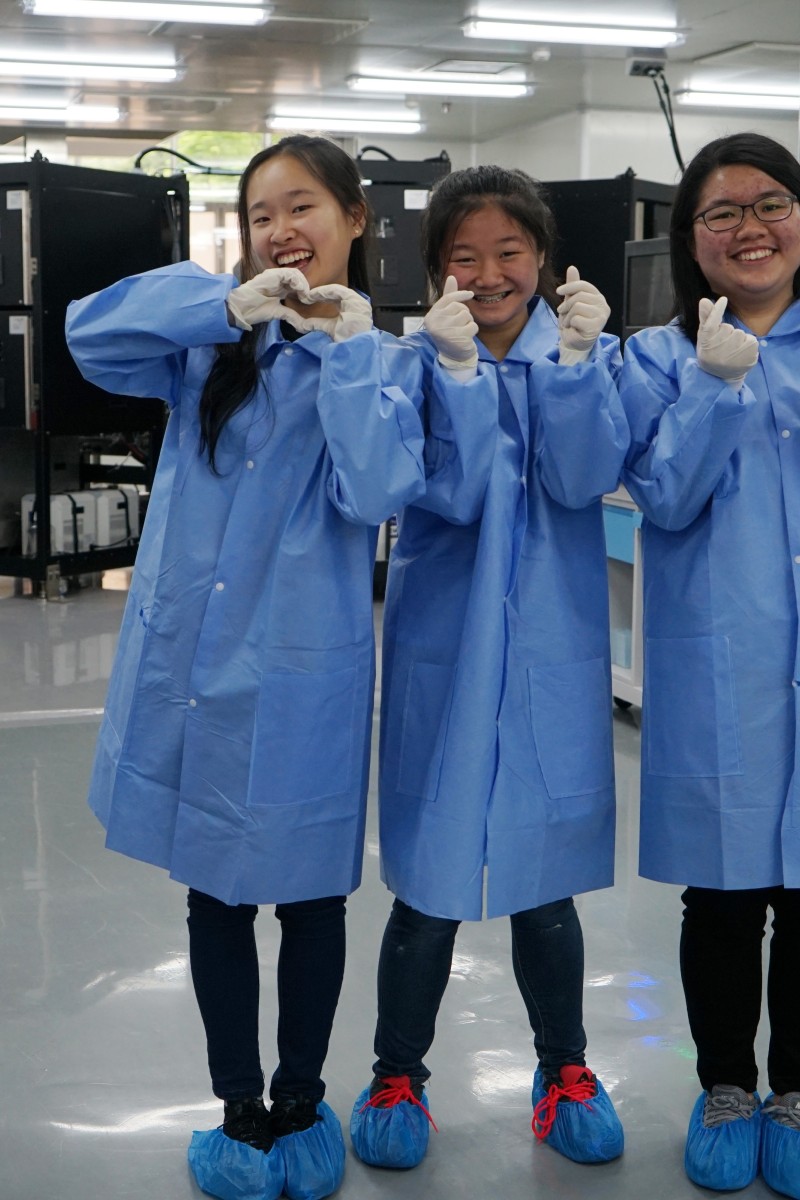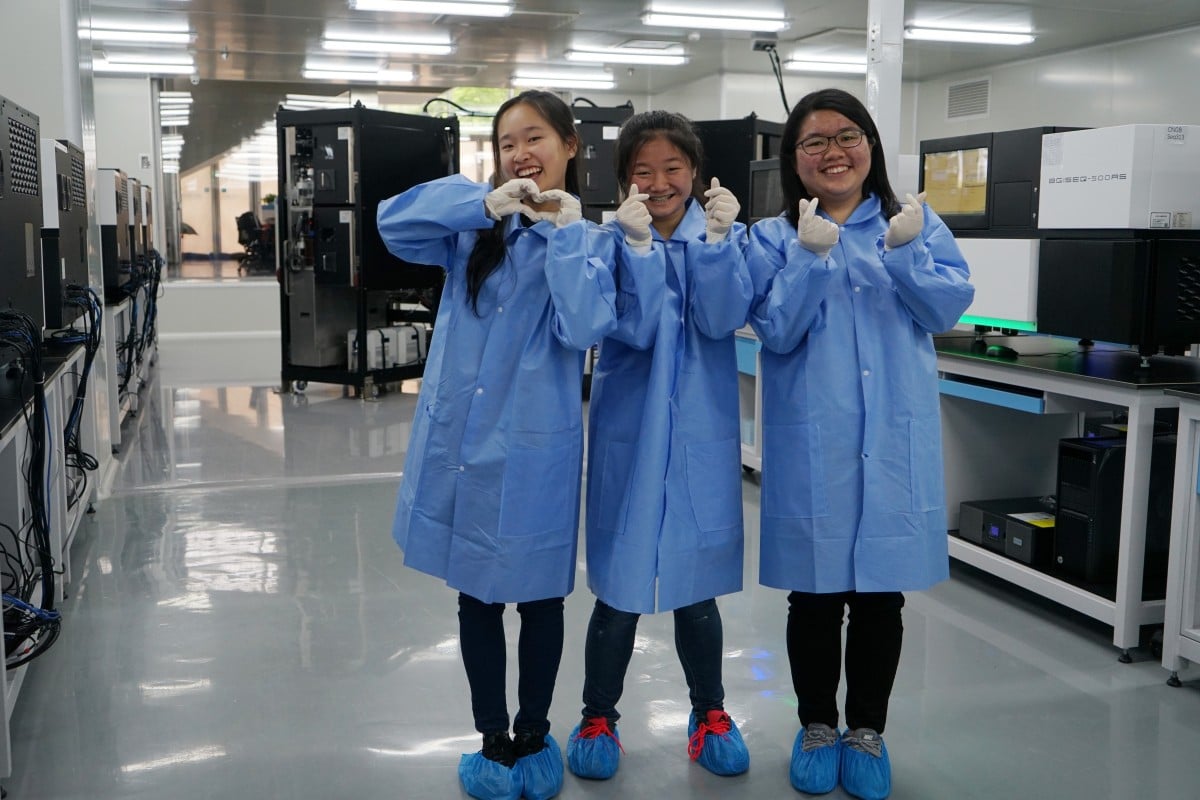
Battling diseases, gender inequality and birth defects at the China National GeneBank
Junior reporters went to China's first and only gene bank to witness how DNA is sequenced and learn about the centre’s long term goals
 YP cadets...working hard to bring your behind the scenes coverage of of a DNA sequencing lab.
YP cadets...working hard to bring your behind the scenes coverage of of a DNA sequencing lab.China National GeneBank opened its doors in Shenzhen last September. It is the world’s fourth national gene bank after similar centres were established in the United States, Britain and Japan.
The Genebank stores more than 20 million bio-samples, including those from plants, human genetic resources, animals, earth microbes, human meta microbes, and marine biodiversity and disease resources. There are multi-level storage spaces for different samples, to keep them each at their optimum storage temperature. For example, tissues and living cells are stored in liquid nitrogen where temperatures range from -130 to -196 degrees Celsius.
Such advanced facilities help the Genebank to develop and maintain international competitiveness and influence in the field of genomics.
Upon arrival, we were greeted by huge sculptures of mammoths at the gate. Mammoths are elephant-like mammals that became extinct some 4,500 years ago when they were unable to adapt to the changing environment after the Ice Age. We later learned that the gene bank is hoping to bring these animals back to life, having discovered a well-preserved mammoth fossil in eastern Siberia in 2012. However, many challenges (such as finding a suitable surrogate mother because even elephants are not big enough to carry a mammoth embryo to term) await these intrepid scientists.
It wasn’t only the potential of reviving long extinct creatures a la Jurassic Park which we found fascinating. The environment surrounding the gene bank was also breathtaking, and the architecture seemed specifically designed to be in tune with the natural world. Surrounding the building were peach gardens, greenery, and a river where we saw beautiful black swans.
Once inside, we were given tours of the three core laboratories in the gene bank – the sample preparation lab, library construction lab, and the sequencing lab. Before entering each lab, we had to put on laboratory coats, masks, gloves and shoe covers to avoid contamination of samples, which had the added benefit of making us look and feel like real scientists, too.
Sample preparation laboratory
The sample preparation laboratory is divided into three areas: DNA extraction, RNA extraction and quality monitoring. The basic principle of extraction is the collection of nucleic acid (for example, DNA and RNA, which are the “blueprints” for building all the parts that make up our bodies ) from inside the cells and processing them so that non-coding parts are removed.
Biological samples like blood, animal and plant tissue, saliva, and bacteria undergo processes such as multiple precipitations and incubation periods to concentrate and purify the target genetic material needed for the next step.
Library construction laboratory
After the extraction of the genetics blueprints, scientists at the library construction laboratory perform a series of experiments to locate the genetic information which can be passed to the next stage.
Through reactions which separate the double helix structure of DNA we see in our textbooks into single strands, the head and tail of the genetic information for detection will be enclosed by “adapters”, which have fixed and easily recognisable nucleotide sequences.
These let the scientists know the beginning and end of individual compounds, much like we read music and can see the start of the next stanza. Once processed into these “libraries”, the genetic material is then ready for sequencing.
Sequencing laboratory
Following library construction comes sequencing, the process of detecting individual nucleotide sequences. Everyone needed to go through a “wind shower” to blow away any accumulated dust before entering this lab.
The process begins by loading the library onto a tiny chip. After treatment with chemical markers, each nucleotide base (A, T, C, or G) will give off a different fluorescent signal. These fluorescent signals will then be digitalised using 150 domestically developed desktop gene- sequencing machines.
The scientists plan to apply the data to different fields such as human health, eradication of disease, agricultural advances, and reducing birth defects.
Meeting passionate young scientists
At the end of the day, we met two young scientists working at the gene bank, Wan Qian and Gu Ying. Both are women who loved biology from a young age and specialise in evolutionary genetics.
“I loved reading science fiction when I was small, especially those about aviation. Science about nature is my favourite subject, followed by geography. That’s why I chose to work and explore the scientific world,” Wan said. Gu was inspired by a quote from Chen Zhangliang, a pioneer in the research of transgenic plants.
Chen said, “The 21st century is the world of life science”, so Gu chose biotechnology as her major and works on the relationship between disease and growth, which may be two sides of the same scientific coin.
Even today, some may think that males are better than females in the scientific field but these two brilliant researchers prove them wrong. “This is certainly not the case. In fact, doing scientific experiments and research requires detailed observation and patience. I believe girls have the competitive edge over boys in this career. We used to joke that being a scientist is like doing household chores. When doing an experiment, one has to control the temperature or the quantity of samples carefully, and skills like these can be mastered and learned while doing housework. We actually have many female employees working in the gene bank,” Gu said.
When asked about the potential harmful effects of experimenting with DNA and the backlash against genetically modified (GM) products, they said: “There is no evidence proving GM products are harmful. On the other hand, there are measurable positive effects such as making a plant more resistant to pesticides and improving crop yield.” Whether there are long-term negative effects remains to be seen.
Our very own gene tests!
At the end of the day, we were given the chance to undergo a gene test to find out whether you are the type of person that put on weight easily. After gathering two millilitres of saliva in a test tube (a very difficult process - it’s really hard to produce so much saliva!), we added a solution to preserve the DNA and sealed the bottles.
A few weeks later, we got our results back and some of us realised we were in the “Don’t get fat easily” genetic group and could no longer blame our parents for giving us “fat genes”. Instead, we would have to take the responsibility for living a healthy lifestyle, and the Genebank lab provided each of us with a customised exercise routine tailored according to our genes, and current BMI (body mass index).
In addition, they analysed our blood sugar and fat regulation levels and also gave us advice on which types of food were easier for our bodies to handle. It’s a scientific way to change our eating habits for the better and definitely motivates us to lead healthier lives.